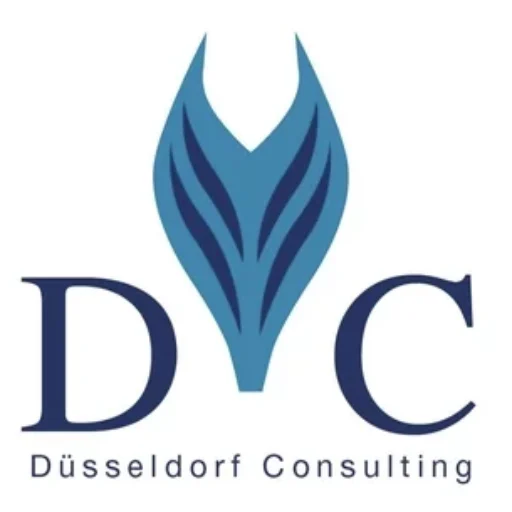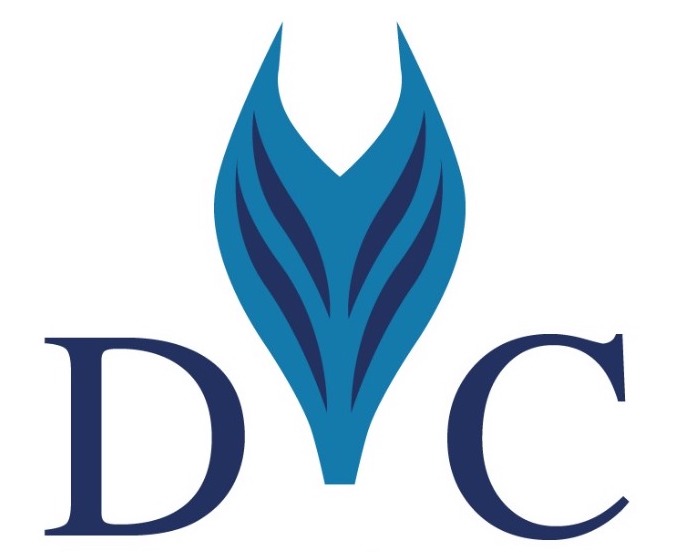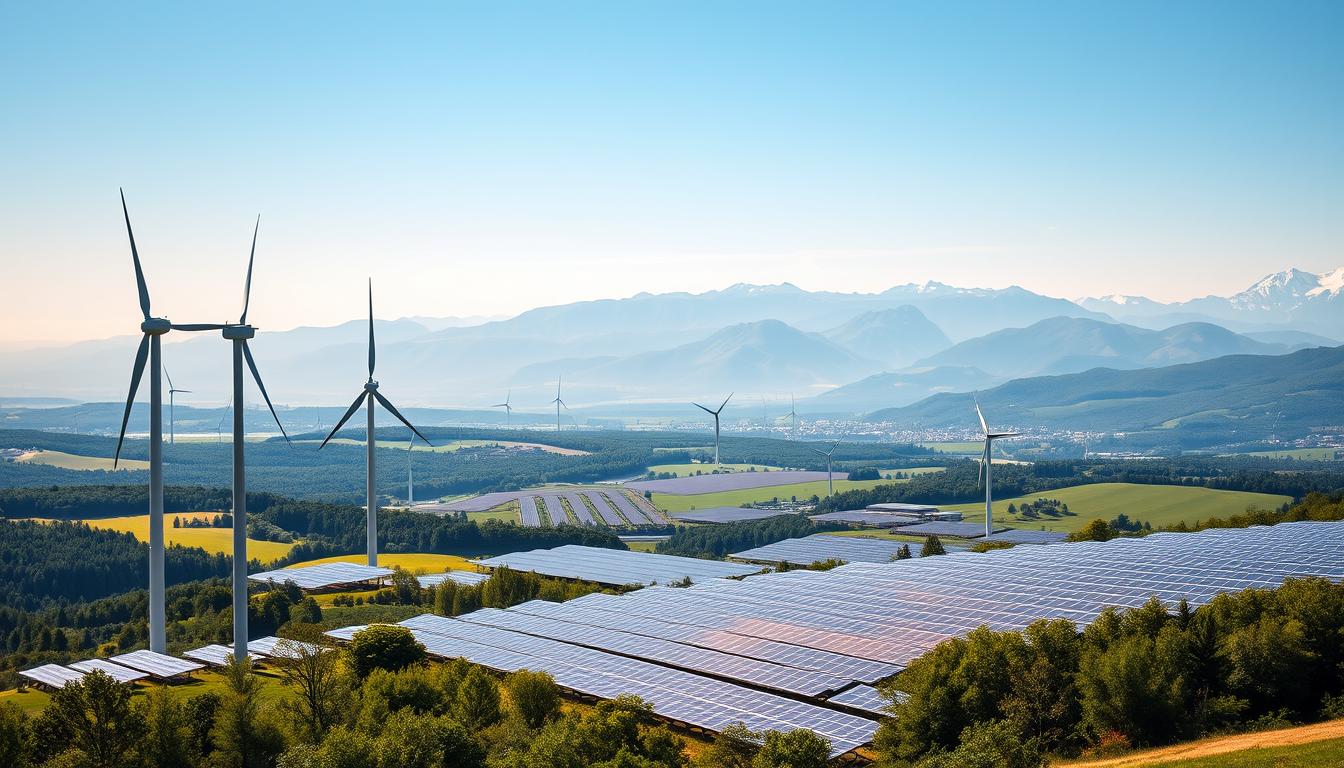Germany is at the forefront of the renewable energy revolution, with ambitious targets to reach 100 to 110 GW of onshore wind, 30 GW of offshore wind, and 200 GW of solar energy capacity by 2030. Düsseldorf Consulting GmbH, located at Königsallee 22, 40212 Düsseldorf, is committed to supporting this transition.
The country’s commitment to renewable energy sources is driving growth and innovation. As a leader in the industry, Düsseldorf Consulting GmbH is dedicated to helping Germany achieve its renewable energy goals.
Key Takeaways
- Germany’s renewable energy targets include 100-110 GW of onshore wind capacity by 2030.
- The country aims to achieve 30 GW of offshore wind capacity by 2030.
- Solar energy capacity is expected to reach 200 GW by 2030.
- Düsseldorf Consulting GmbH supports the transition to renewable energy.
- The company’s expertise is crucial in achieving Germany’s renewable energy goals.
Overview of Renewable Energy in Germany
Germany’s transition to renewable energy is gaining momentum, with over 50% of its gross electricity consumption coming from renewable sources in 2023, reaching nearly 52% for the full year. This significant milestone underscores the country’s commitment to sustainable energy and its efforts to reduce dependence on fossil fuels.
The renewable energy sector in Germany is characterized by substantial growth in solar and wind energy. Key players in the market include major energy companies and innovative startups, all contributing to the development and implementation of green energy solutions. Germany’s climate goals are driving the demand for renewable energy, with policies and regulations supporting the expansion of renewable capacities.
The country’s renewable energy policies are designed to promote the use of sustainable energy sources. These policies include incentives for investments in renewable energy projects and measures to ensure a stable and efficient integration of renewable energy into the grid.
As Germany continues to lead in renewable energy, the focus remains on enhancing green energy solutions and improving the overall energy infrastructure. The progress made in 2023 is a testament to the effectiveness of Germany’s renewable energy strategies and its commitment to a sustainable energy future.
Renewable Energy Sources
The renewable energy landscape in Germany is dominated by solar power, wind energy, and biomass, showcasing a diverse energy mix. Germany’s installed solar photovoltaic (PV) capacity has seen significant growth, surpassing 100 GW at the start of 2024.
Solar Power: The country has witnessed a substantial increase in solar PV installations, driven by government incentives and declining technology costs. This growth has positioned solar power as a crucial component of Germany’s renewable energy strategy.
Wind Energy: Wind power has also played a vital role in Germany’s energy mix, contributing 136.4 TWh and making up about one-third of the total electricity output. The country’s wind energy capacity continues to grow, with ongoing investments in both onshore and offshore wind farms.
Biomass: Biomass is another significant contributor to Germany’s renewable energy landscape, particularly in regions with strong agricultural activity. The use of biomass for energy production helps reduce reliance on fossil fuels and supports rural economies.
The combination of these renewable energy sources has enabled Germany to make significant progress towards its clean energy goals. Some key benefits of these sources include:
- Reduced greenhouse gas emissions
- Increased energy security
- Job creation in the renewable energy sector
As Germany continues to expand its renewable energy capacities, it is likely to remain a leader in the global transition to a more sustainable energy future.
Government Policies and Regulations
Germany’s renewable energy sector has flourished due to the government’s forward-thinking policies and regulations. The government has implemented several initiatives to support the growth of renewable energy, including the Renewable Energy Sources Act (EEG) and feed-in tariffs.
The Renewable Energy Sources Act (EEG) is a pivotal policy that has provided a stable framework for investors, thereby promoting the development of renewable energy sources. It ensures that renewable energy producers are paid a fixed price for the electricity they produce, making it more viable for companies and individuals to invest in renewable energy technologies.
Feed-in tariffs have also been instrumental in driving the adoption of renewable energy. By guaranteeing a fixed payment for renewable energy producers, the government has encouraged the development and integration of renewable energy sources into the national grid.
Key Features of the Renewable Energy Sources Act (EEG)
- Priority to renewable energy sources in grid allocation
- Fixed tariffs for renewable energy producers
- Promotion of diverse renewable energy technologies
The impact of these policies can be seen in the following table, which highlights the growth of renewable energy capacity in Germany over the years.
| Year | Renewable Energy Capacity (GW) | Growth Rate (%) |
|---|---|---|
| 2010 | 55 | 10 |
| 2015 | 80 | 15 |
| 2020 | 120 | 20 |
The government’s commitment to renewable energy is further demonstrated by its ongoing efforts to update and refine the EEG and other related policies. This ensures that Germany remains on track to meet its renewable energy targets and continues to be a leader in the global transition to a more sustainable energy mix.
In conclusion, the combination of supportive policies, regulations, and initiatives has been crucial in driving the growth of renewable energy in Germany. As the country continues to evolve its energy policies, it is likely that renewable energy will remain a cornerstone of Germany’s energy strategy.
Innovations in Renewable Technologies
Innovations in renewable energy technologies are crucial for Germany’s sustainable future. The country is heavily investing in green energy solutions to reduce its carbon footprint and achieve its climate goals.
The renewable energy sector is driven by advancements in various technologies. Solar panel efficiency has seen significant improvements, making solar energy a more viable option. For instance, the development of bifacial solar panels has increased energy output by allowing panels to capture sunlight from both the front and back sides.
Another area of innovation is offshore wind developments. Germany has been at the forefront of offshore wind technology, with larger turbines and more efficient installation methods being developed. These advancements have made offshore wind farms more cost-effective and capable of generating more power.
Energy storage solutions are also critical for the continued growth of renewable energy. Advanced battery technologies are being developed to store excess energy generated by renewable sources, ensuring a stable and reliable energy supply. Some of the key energy storage solutions include:
- Lithium-ion batteries
- Flow batteries
- Hydrogen storage
These innovations are part of Germany’s broader clean energy strategies, aimed at reducing reliance on fossil fuels and mitigating climate change. By adopting these cutting-edge technologies, Germany is setting a precedent for other countries to follow in the transition to a more sustainable energy mix.
The impact of these innovations can be seen in the increasing share of renewable energy in Germany’s energy mix. As the technology continues to evolve, we can expect even greater efficiencies and cost reductions, further accelerating the transition to a sustainable energy future.
Regional Strategies for Renewable Energy
The path to a sustainable energy future in Germany is being shaped by regional strategies that leverage local resources. Different regions in Germany have adopted unique approaches to renewable energy, reflecting their distinct geographical and economic characteristics.
Bavaria, for instance, has been at the forefront of solar initiatives, capitalizing on its abundant sunlight to generate clean energy. Solar energy projects in Bavaria have not only contributed to the region’s energy needs but have also served as a model for other regions.
In contrast, the North Sea region has focused on developing wind farms, harnessing the strong coastal winds to produce electricity. This initiative has positioned Germany as a leader in offshore wind energy, contributing significantly to its renewable energy targets.
Local biomass usage is another strategy being promoted across various regions. By utilizing organic waste and agricultural residues, communities are reducing their reliance on fossil fuels and lowering greenhouse gas emissions.
“The decentralization of energy production through renewable sources is a key factor in Germany’s energy transition. Regional strategies are crucial in this context, as they allow for tailored approaches that meet local needs and resources.”
The effectiveness of these regional strategies can be seen in the diverse energy landscapes across Germany. A comparative analysis of different regions reveals the strengths and challenges associated with various renewable energy sources.
| Region | Primary Renewable Energy Source | Notable Initiatives |
|---|---|---|
| Bavaria | Solar Energy | Large-scale solar farms |
| North Sea Region | Wind Energy | Offshore wind farms |
| Rural Areas | Biomass | Biogas plants using agricultural waste |
These regional strategies not only contribute to Germany’s renewable energy goals but also foster local economic development and energy independence. As Germany continues to expand its renewable energy capacity, the success of these regional initiatives will be crucial in shaping the country’s sustainable energy future.
Economic Impacts of Renewable Energy
Germany’s renewable energy sector has emerged as a key driver of economic development, fostering job creation and investment. The growth of renewable energy sources in Germany has not only contributed to a more sustainable energy mix but has also had a profound impact on the economy.
The shift towards sustainable energy Germany has led to the creation of new job opportunities in manufacturing, installation, and maintenance of renewable energy technologies. This has resulted in a significant reduction in unemployment rates, particularly in regions with high concentrations of renewable energy installations.
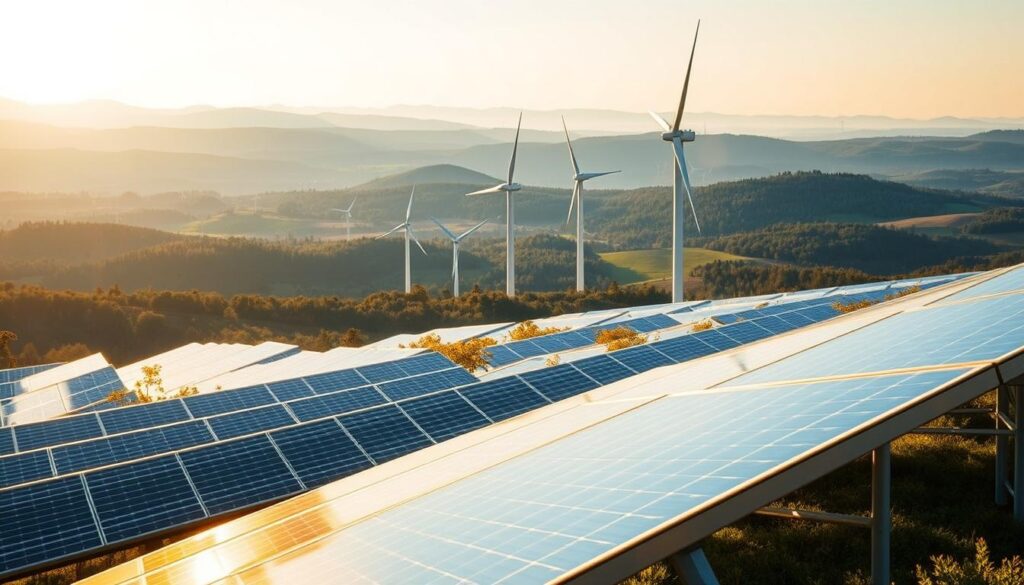
The renewable energy sources Germany are diverse, including solar, wind, and hydroelectric power. The development and maintenance of these sources have stimulated local economies, contributing to regional development and economic diversification.
Investment in renewable energy has also attracted significant capital, both domestically and internationally. This influx of investment has supported the growth of businesses related to renewable energy, from technology manufacturers to service providers, further boosting the economy.
The economic benefits of transitioning to renewable energy are multifaceted. Not only does it reduce dependence on imported fuels, thereby improving the trade balance, but it also enhances energy security by diversifying the energy mix.
In conclusion, the economic impacts of renewable energy in Germany have been overwhelmingly positive, driving job creation, investment, and regional development. As the country continues to expand its renewable energy sources Germany, it is likely that these economic benefits will continue to grow, contributing to a more sustainable and prosperous future.
Challenges Facing Renewable Energy Deployment
As Germany continues to expand its renewable energy capacity, it must navigate various deployment challenges. The country’s ambitious targets for reducing greenhouse gas emissions and increasing the share of renewables in its energy mix are well-known, but achieving these goals is not without its obstacles.
One of the primary challenges is infrastructure limitations. The existing grid infrastructure in Germany is not always equipped to handle the variable output from renewable sources like wind and solar. This can lead to bottlenecks in transmission and distribution, potentially curtailing the output from renewable energy installations. Upgrading the grid to accommodate more renewables is essential but requires significant investment and planning.
Regulatory hurdles also pose a significant challenge. The renewable energy policies in Germany have evolved over time, but complexity and frequent changes can create uncertainty for investors and developers. Streamlining regulatory processes and providing clear, stable policies can help mitigate these issues. For more insights on navigating these challenges, visit this resource.
Public acceptance is another critical factor. While there is broad support for renewable energy in Germany, local opposition to specific projects, such as wind farms or transmission lines, can be intense. Engaging with local communities and addressing their concerns through transparent planning processes can help improve public acceptance of new renewable energy projects.
In conclusion, while Germany has made significant strides in deploying renewable energy, addressing the challenges of infrastructure, regulation, and public acceptance is crucial for continued progress. By tackling these issues head-on, Germany can continue to lead the way in the transition to a more sustainable energy future.
Future Trends in Renewable Energy
The future of renewable energy in Germany is being shaped by technological advancements and international collaborations. As the country continues to transition towards a more sustainable energy future, these factors will be critical in driving progress.
Germany’s commitment to achieving its decarbonization goals is evident in its clean energy strategies. The country is focusing on expanding its renewable energy capacity, with a particular emphasis on wind and solar power. According to recent reports, Germany aims to achieve 80% of its electricity from renewable sources by 2030, a goal that is considered well within reach by the country’s energy minister.
One of the key trends in renewable energy is the increasing adoption of eco-friendly energy practices. This includes the development of more efficient solar panels and wind turbines, as well as innovative energy storage solutions. The integration of these technologies is expected to play a crucial role in Germany’s energy transition.
“The energy transition is not just about generating electricity from renewable sources, but also about creating a sustainable and efficient energy system.”
The role of international collaborations cannot be overstated. Germany is working closely with other countries to share knowledge, technologies, and best practices in renewable energy. This cooperation is expected to drive innovation and accelerate the global transition to a low-carbon economy.
| Renewable Energy Source | Current Capacity | Projected Capacity by 2030 |
|---|---|---|
| Wind Power | 60 GW | 100 GW |
| Solar Power | 50 GW | 80 GW |
| Biomass | 10 GW | 15 GW |
As Germany moves forward with its renewable energy agenda, it is likely to serve as a model for other countries. The country’s commitment to eco-friendly energy practices and its focus on technological innovation will be key factors in achieving its ambitious climate goals.
Case Studies of Successful Renewable Projects
Successful renewable energy initiatives in Germany serve as a model for sustainable development. Various regions have seen significant advancements in renewable energy projects, contributing to a more sustainable energy future.
One notable example is the solar parks in Brandenburg. These projects have not only increased the region’s renewable energy output but have also created new economic opportunities. The development of solar parks demonstrates the potential for renewable energy initiatives Germany to drive growth and sustainability.
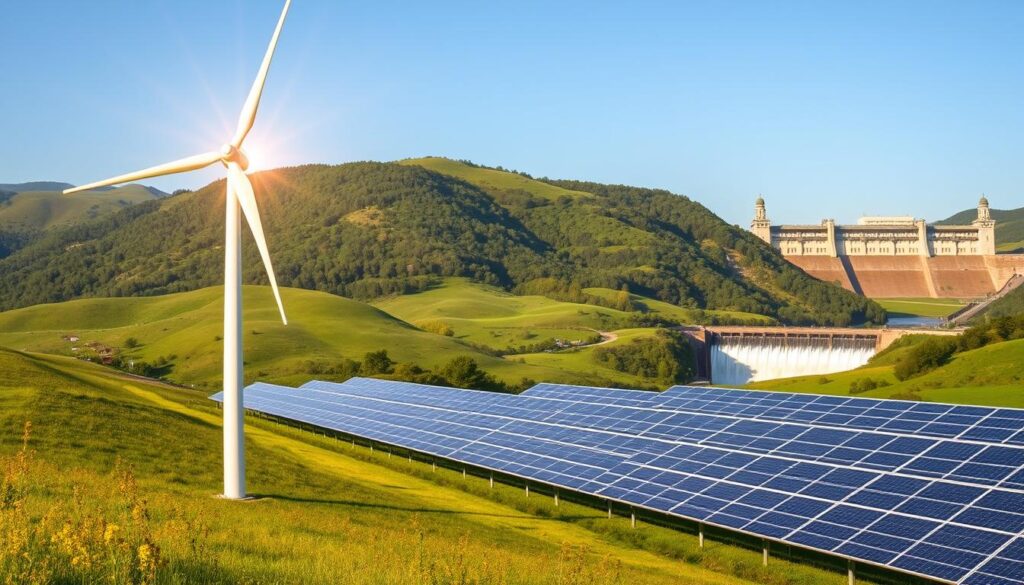
In Schleswig-Holstein, wind energy developments have been instrumental in positioning the region as a leader in renewable energy production. The success of these wind energy projects underscores the importance of regional strategies in achieving national sustainable energy Germany goals.
North Rhine-Westphalia (NRW) has been at the forefront of biomass innovations, showcasing the diversity of renewable energy sources being explored across Germany. These biomass projects highlight the potential for renewable energy to contribute to a more sustainable and environmentally friendly energy mix.
The success of these renewable energy projects across different regions in Germany illustrates the country’s commitment to reducing its carbon footprint and transitioning to a more sustainable energy future. As Germany continues to invest in sustainable energy Germany, these case studies will serve as valuable examples for future renewable energy initiatives.
Conclusion: The Path Forward for Germany
Germany’s transition towards a more sustainable energy future is gaining momentum, driven by innovative renewable energy strategies and green energy solutions. As the country continues to push forward with its ambitious targets, the importance of community engagement, long-term sustainability goals, and continued innovation cannot be overstated.
Effective renewable energy strategies in Germany will be crucial in achieving its climate objectives. By fostering a supportive environment for green energy solutions, Germany can reduce its reliance on fossil fuels and mitigate the impacts of climate change.
The path forward will require a collaborative effort from policymakers, industry stakeholders, and local communities. By working together, Germany can unlock the full potential of its renewable energy resources, driving economic growth and reducing carbon emissions.
As Germany continues on its path towards a more sustainable energy future, the integration of cutting-edge technologies and innovative renewable energy strategies will be vital. This will not only help the country achieve its climate targets but also position it as a leader in the global transition to a low-carbon economy.
